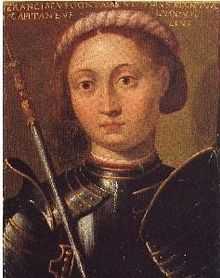Francesco I Gonzaga

Francesco I Gonzaga (1366 – 7 March 1407) was ruler of Mantua from 1382 to 1407. He was also a condottiero.
Succeeding his father in 1382, he led a policy of balance between the nearby powers of the Visconti of Milan and Venice. In 1380, he married Agnese, daughter of Barnabò Visconti.[1] When she was executed in 1391 under accusations of adultery, Francesco switched his allegiance to Venice, also to protect his land from the increasing power of Gian Galeazzo Visconti.
In 1393, he remarried, to Margherita Malatesta, who carried in the Gonzaga family the hereditary illness of osteomalacia, which appeared periodically in Mantua's rulers until the 16th century. Francesco had subsequently to defend his lands from Gian Galeazzo's assault, but the latter's death in 1401 solved the conflict.
Francesco Gonzaga is remembered as the builder of the Castle of San Giorgio,[2] the nucleus of Ducal Palace of Mantua, the Gothic façade of the city cathedral, the bell tower of the Basilica of Sant'Andrea, as well as the Sanctuary of Santa Maria delle Grazie at Curtatone.
| Preceded by Ludovico II |
Lord of Mantua 1382–1407 |
Succeeded by Gianfrancesco I |
| Wikimedia Commons has media related to Francesco I Gonzaga. |
References
- ↑ Donald C. Sanders (2012). Music at the Gonzaga Court in Mantua. Lexington Books. pp. 3–. ISBN 978-0-7391-6726-7. Retrieved 14 August 2013. "Luigi Gonzaga's grandsons Francesco and Lodovico murdered their older brother Ugolino in 1362 and Francesco ... his way to succeeding his father.13 At the age of fourteen Lodovico's son Francesco (1366–1407) married Agnese Visconti, ..."
- ↑ Roland Sarti (1 January 2009). Italy: A Reference Guide from the Renaissance to the Present. Infobase Publishing. pp. 318–. ISBN 978-0-8160-7474-7. Retrieved 14 August 2013. "Francesco I (1366–1407) built the Castle of San Giorgio in Mantua and ..."
|